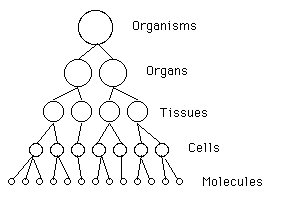From John Robb’s Global Guerrillas blog…
HOLONS AND ECONOMIC RESILIENCE
Here’s an excellent parable from Herbert Simon that may help you get your head around how holonic theory works (and why it is useful):Suppose each watch consists of 1000 pieces. The first watchmaker constructs the watch as one operation assembling a thousand parts in a thousand steps. The second watchmaker builds intermediate parts, first 100 modules of 10 parts each, then 10 subassemblies of 10 modules each, then a finished watch out of the subassemblies, a somewhat longer process, 110 steps longer.
It would seem that constructing a watch in a single sequential process would progress faster and produce more watches. Alas, life being what it is, we can expect some interruptions. Stopping to deal with some environmental disturbance, like a customer, the watchmaker puts down the pieces of an unfinished assembly. Each time the first watchmaker puts down the single assembly of 1000, it falls apart and must be started anew, losing up to 999 steps. Interrupting the second watchmaker working on a module of 10 using hierarchical (in the first sense) construction means a loss of at most 9 steps.
For organizing complexity, the moral is this: taking a few extra steps in the short run, saves many steps in the long run.
The big problem with our modern economy is that it has been integrated into a single global system (or network). There aren’t any autonomous and self-sufficient intermediate steps (scale invariant holons), only mutually interdependent parts (company, community, state, nation, etc.). This means that nearly the entire economy must be operating in order for the economy to operate, anything less and the entire thing breaks down (think Fall 2008). The absence of a holonic structure also makes it very difficult to construct new complex systems that can solve equally complex problems.
The solution to this impasse is to create scale invariant holons at intermediate layers within our economy. Or, more simply, the minimum necessary step to building economic scale invariant holons is focus on self sufficiency in the necessities critical to economic life (as opposed to all systems, regardless of criticality) such as: food, energy, water, and many basic products. So where do we start? Given the trends in technology and social structure that are currently underway, the best place to accomplish this goal is as the local community level. To build resilient communities.
* Read: Resilient Communities and Scale Invariance for more about how this works.
Apart from hierarcic systems (as in business or military organisations), the different holarcic system levels consists of each other, they are subsystems (or supersystems) to each other. When the subsystems join in a supersystem, new characteristics emerge that can’t be deduced from the qualities of the subsystems (emergence). In the same way as you can’t descibe a human as a ‘supercell’, you can not describe an ecosystem as a ‘superorganism’ or the ecosphere as a ‘superecosystem’. They are different objects with some characteristics that not can be derived from the characteristics of the subsystems.
Holarchy is a word coined by Arthur Koestler. It is a combination between the Greek word ‘holos’ meaning whole and the word ‘hierarchy’. It is a hierarchically organized structure of units or entities that are called ‘Holons’.
Each Holon could be regarded as either a whole or as a part depending on how one looks at it. A Holon will look as a whole to those parts beneath it in the hierarchy, but it will look as a part to the wholes above it. So, a Holarchy is then a whole that is also a structure of parts that are in themselves wholes.
Here is a biological example of a Holarchy:
Just about anything you would choose to study could be regarded as either an independent whole or as a part of something bigger. A lot of interesting and puzzling phenomena come out of this dualism. It creates dichotomies of independence versus integration, individuation versus unity, competition versus cooperation, cause versus effect, etc.


A related quote from “The End of Money and the Future of Civilization (Thomas H. Greco Jr.) – Highlight Loc. 2016-20
“I often use the analogy of the small boat harbor to convey the general idea of how local communities can protect their small enterprises while remaining open to the global economy. The process of globalization, while having many positive aspects, has thus far been carried out in such a way as to be destructive to small businesses, local economies, and democratic governance. It is as if there were a policy to remove the breakwaters from every small boat harbor in the world, the effect of which is to expose small boats to the turbulence of the open sea. As I put it in one of my lecture presentations- a rising tide may lift all boats, but the tidal wave of globalization smashes all but the biggest.
…
The credit clearing exchange is the key element that enables a community to develop a sustainable economy under local control and to maintain a high standard of living and quality of life.